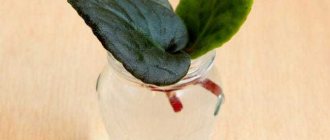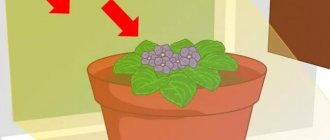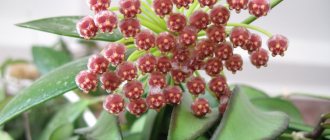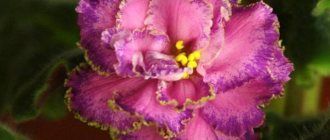Violets are one of the most common indoor flowers, which captivate more and more fans and breeders with their variegation and beauty, and this means the regular breeding of new varieties. So, for example, in 2011 the variety “LE-Isadora ” appeared, which will be discussed.
Dear readers! For you, we have created communities on social networks in which useful articles and interesting ideas are published several times a day! Subscribe and receive useful content in a convenient format!
Dancing on tables
She left school before she was thirteen and began educating herself.
Classical dance lessons led nowhere. Rigid rules, clear movements, a certain order of steps - all this was not for her. So ballet lessons from the famous ballerina Mademoiselle Bonfanti quickly ended. The twenty-year-old dancer went to London in 1898. There Isadora quickly gained a circle of admirers, shocking the prim capital. She danced on the tables, half naked, in a short robe similar to an ancient Greek chiton. They paid well for such a curiosity, and soon Isadora had money.
“I'm an atheist! Atheist!
Isadora was a very eccentric person. During the dance, she could go into the hall or scream. One day she started shouting from the stage: “I’m an atheist! Atheist! Another time, at a concert in Boston, during the final chords, she waved a scarlet scarf: “It’s red! And I’m the same!” This did not increase her popularity.
Soviet Russia seemed to Isadora an ideal place for the development of her dance school. Moreover, the People's Commissar of Education Anatoly Lunacharsky himself invited and promised comprehensive financial assistance. In reality, everything turned out to be not so rosy. Government support did not last long; Duncan had to starve and freeze in an apartment requisitioned from the ballerina Ekaterina Geltser.
The dancer, not accustomed to working on enthusiasm, began to think about returning to Europe, which she so criticized for the bourgeoisie and inequality she hated.
Landing rules
To grow Isadora you will need a container filled with special soil for violets. Self-prepared soil is also suitable, which includes:
- sand;
- leaf soil;
- peat;
- wood ash;
- sphagnum moss.
A small, narrow pot with a diameter of 10-12 cm is suitable as a container for planting. You should not take a smaller container, because crowding will cause the buds to wither, but a large pot will not be beneficial either. A place not occupied by roots will become swampy, and this will lead to:
- the appearance of fungus;
- rotting of the root system.
Clay and ceramic pots are ideal. It is not advisable to take plastic products. Although they are lightweight and durable, they do not allow air to pass through.
Replanting is carried out by completely replacing the soil or by transshipment. The first option is used if the plant is sick or the soil has become hard and does not allow moisture to pass through. Transshipment is carried out when you need to increase the size of the pot.
Diseases and pests
Diseases and pests do not allow breeders to relax.
Late blight is a common disease. It occurs when replanting and using new soil. With it, the leaves become covered with spots.
For protection, superphosphate is added to the pot. For thrips and nemanthodes, it is best to use Biodan or nemanthicides.
How to propagate at home
The African flower is unpretentious. Le Isadora does not require more attention than other Saintpaulias. It is not difficult to care for her.
For Saintpaulias, including Les Isadoras, the “golden rule” of flower growers is especially relevant: “it is better to under-water than over-water.” Do not allow the soil to become waterlogged and water to stagnate in the pot. This leads to diseases and rotting of the roots and stem. You need to water as needed, which can be determined by the dried top layer of soil. The frequency of watering depends on the time of year. In summer, when the soil dries quickly, you need to water every other day or two, and in winter less often - about 2 times a week.
It is not recommended to water the violet with cold tap water. The liquid must be warmed to room temperature. It is best to let the water collected from the tap sit for three days. This way it will heat up a little and cleanse itself, as harmful light impurities will evaporate, and heavy ones will settle to the bottom.
There are 3 ways to water Saintpaulia:
- Top, or into the pot: pour water carefully along the edge of the pot, trying not to get on the leaves or in the center of the rosette.
- Bottom, or in the pallet. You can use a wide container of water into which the pot is immersed for half an hour. Then you need to let the excess liquid drain. The advantage is that there is no danger of the soil becoming too wet. The plant will take as much water as it needs.
- Wick method: water flows through a wick (a cord made of synthetic fabric), one part of which is placed at the bottom of the pot under the roots, and the other hangs from a hole at the bottom into a container of water over which the pot is fixed. The advantage of this method is that it eliminates the possibility of waterlogging and drying out of the soil.
Important! In winter, in a cool room, wick watering should be abandoned. In such conditions, the roots may rot
Fertilizer application
https://www.youtube.com/watch?v=https:accounts.google.comServiceLogin
It is necessary to pay attention to the composition of the fertilizer, because at different periods of development the flower needs different nutrients. Young bushes and children need fertilizer with a high nitrogen content, which helps to grow green mass. And when the rosette produces buds and blooms, it already needs more potassium and phosphorus, and the amount of nitrogen is reduced to a minimum
And when the rosette produces buds and blooms, it already needs more potassium and phosphorus, and the amount of nitrogen is reduced to a minimum.
Trimming
Saintpaulia Le Isadora does not need pruning. But to improve the appearance, you can pinch the lower leaves. They are removed because they lose the brightness of their color and take away from the plant the strength necessary for flowering. For the same purpose, you should get rid of children, yellowed leaves and flower stalks with faded buds. Usually, excess elements are not cut off, but torn off.
- On the mother bush, the children are cut off with a sharp knife and the largest of them (about 4 cm in length) are selected for planting.
- The selected cuttings are placed in cups with settled warm water and placed in a sunny place.
- When the roots appear, you can transplant them into the smallest pots with violet substrate.
- It is advisable to water using the bottom method.
Propagation by leaves is carried out in a similar way:
- In the rosette of an adult Saintpaulia, select a healthy leaf without a defect and break it off or cut it along with the petiole. The upper leaves are not suitable, only the lower ones.
- A cut is made on the petiole of the selected leaf at an angle of approximately 45°C and left for 20 minutes to dry.
- The leaf is placed in a glass of water with the stem down and sent to a sunny place.
- When the roots appear, the cuttings are planted in a small pot with a special substrate.
Cut leaves can be immediately planted in a planting container with soil for violets. In this case, the rooting process goes faster if you create greenhouse conditions by covering the pot with a plastic bag or glass.
Reproduction
"Isadora" can be propagated by leaves and rosette cuttings. In the first case, the healthiest leaf is selected and cut off along with the petiole. Keep in mind that you should only take the lower leaves; the upper ones are not suitable for propagation. An oblique cut is formed on the petiole, left to dry for half an hour, after which it is placed in a glass with the stem down and sent to a well-lit place. As soon as the roots appear, the leaf is moved to the substrate so that rooting continues in it.
Propagation by cuttings has a similar technology. The carefully removed rosette is kept in a container of water, and after the first roots appear, it is planted in a permanent place.
How to grow a violet from a leaf is described in the following video
Violet, description and photo LE-Isadora (E. Lebetskaya)
Violets from breeders of the CIS countries - “A” (LE).
LE-Isadora (E. Lebetskaya).
LE-Isadora, LE-Aisedora (E. Lebetskaya).
Large semi-double and double white flowers with pink prints, studded with fuchsia fantasy touches.
Dark green smooth foliage. Standard. The rosette is large, the leaves are large. In intense light, the leaves droop slightly.
An original variety with double lush flowers, white and pink. Dark purple, blue and crimson strokes and dots are scattered on the pink field. The flowers are large, double and semi-double, fringed, white with lilac prints and strokes and dots of raspberry fantasy. Unfortunately, fantasy fades over time.
The buds open for a long time, maintaining the shape of a rose for a long time. Only after 2 weeks the flower opens completely. A newly opened flower has a variable green border, which later disappears.
The variety blooms readily, the violet always has a head of flowers. The flowers are from 4 cm to 5.5 cm. There are 3-6 flowers on the peduncle. Abundant flowering, however, the flowers quickly wither, especially in hot and winter times. That is, the bouquets that I saw always had several flowers that had changed color due to age. The peduncles are not tall, but not very strong, and do not hold the weight of the flowers.
Prolific and not capricious, it blooms quickly. Gives very attractive sports - pink and beautiful soft purple color with a white edge.
Isadora Duncan is an American innovative dancer and the founder of free dance. She developed a dance system and movement that she associated with ancient Greek dance. Wife of the poet Sergei Yesenin.
Do you know that…?
Chimera flowers look incredibly beautiful and unusual. The corollas of chimeras consist of differently colored sectors, rays extending from the center of the flower. To put it simply, there is a stripe of contrasting color running down the center of the petal. It can be continuous, in the form of spraying or in the form of streaks. Chimera flowers come in simple, semi-double and double varieties, combining chimeric and fantasy designs. For example, the main color of the petal is white or light pink, and the stripe along the petal is a rich blue, dark blue or crimson color; in addition, along the edge of the petal there may also be a coating in the form of strokes or dots of blue color - fantasy. Chimeras obtained from varieties with a contrasting border can also retain it.
Before you buy the violets listed below, carefully read the forums about their behavior on the windowsill. Many of them are very beautiful flowers. However, these can be large rosettes with large and fragile leaves, with leaves rising up or hugging the pot, forming many stepsons that interfere with the formation of a neat rosette, pulling the stem up and growing into a Christmas tree, bending the trunk, rare flowering with long breaks, fallen flowers or they last little and quickly wither, very long and recumbent peduncles, the color of the flower fades quickly, they do not like bright lighting on the windowsill, they are afraid of the slightest drying out or waterlogging, a large percentage of them go into sports or darken the flower.
Are they suitable for your window sill and the conditions that you can create for them? You will look at the flowers for several months, and the rosette will always be in front of your eyes. There are many beautiful flowers, there are much fewer beautiful and neat rosettes, look first at the rosette! Search and you may find a dozen violets with the same flower color if you are not interested in the smallest details as a collector.
• — Annushka (Lebetskaya); • — Arabesque (Lebetskaya); • — Harlequin (Lebetskaya);
Temperature and humidity
The optimal temperature for violets is 20-24 degrees. In such conditions, plants bloom for a long time, large flowers stay on the peduncle for a long time. Violet is a resilient plant that can withstand temperatures down to 5 degrees.
It is important to remember that in summer you need to avoid temperatures above 30 degrees for more than 5 days. And in winter - at low temperatures - it is necessary to reduce watering. Isadora is a violet for which dry air is harmful
It must be sprayed systematically. But it should be remembered that high humidity also leads to the development of fungal diseases
Isadora is a violet for which dry air is harmful. It must be sprayed systematically. But it should be remembered that high humidity also leads to the development of fungal diseases.
To date, about several hundred varieties of violets have been created. Breeders regularly develop new varieties. Each species amazes gardeners with its own characteristics. Violet "Isadora" is distinguished by a beautiful and delicate combination of white and pink, as well as the presence of fuchsia touches and the large size of its flowers. This variety can be called unpretentious, but for proper flowering a number of conditions must be met.
If you find an error, please select a piece of text and press Ctrl+Enter.
Pests attacking a plant
- Scaleworms. Their danger lies in the deformation of the sheet plate. And at the sites of bites, brown or reddish spots appear. If you find this parasite on the leaves or flowers of Isadora, treat it with the following preparations: fitoverm, actara, actellik.
- Thrips. Usually they fall on the surface of plants with flowers or poplar fluff. Their attack is directed by the buds. To protect violet, use acarin, vertimek, gravertin, and dantop.
- Aphid. Also a frequent visitor to Isadora. It is their fault that the young shoots dry out, which prevents the plant from developing and rejuvenating. To combat aphids, use a soap solution. If there are too many of these insects, it is better to resort to insecticidal preparations.
- Different types of mites: red spider mite, cyclamen mite, spider mite. As soon as you notice them on your beauty, immediately treat her with Fitoverm, Akarin or Actellik.
But I would like to note that any violet is a plant that rarely succumbs to attacks by pests and diseases, if you follow all care recommendations. Therefore, in addition to treating the plant with various means, reconsider Isadora’s living conditions.
And in conclusion, we note that all the points listed above are not particularly difficult to comply with. You just need to do everything on time and systematically. And then the beautiful Isadora will thank you with rapid and long-lasting flowering and no problems with it. Feel free to purchase this symbol of tenderness and grace for yourself.
If you find an error, please select a piece of text and press Ctrl+Enter.
Growing conditions
Despite the unpretentiousness of the “Isadora” violet, it is necessary to devote a lot of time to caring for it, as it has some features. Experienced breeders share their experience and recommend paying close attention to the issue of watering and fertilization. By following some simple tips you can grow a healthy and beautiful flower.
The soil
The soil for each variety of violets is selected individually. First of all, it must be loose, breathable soil with good moisture holding capacity. For this variety, a suitable substance includes high-moor peat, vermiculite, perlite, charcoal and antibacterial swagnum moss. The latter is very important as a disinfectant and antifungal property.
Temperature
Temperature is an important component of proper care. For violets of any variety, temperature means a lot. “Isadora” is a very heat-loving plant; it is recommended to keep the room temperature at 23 degrees Celsius.
Temperatures below are strictly prohibited. At night, temperatures above 18 degrees will be acceptable for violets.
Lighting
The lighting must be correct. If you want the flower to be healthy and beautiful, you need to provide “Isadora” with at least 12 hours of light baths.
But at the same time, it is necessary to exclude direct sunlight from hitting the plant if it is standing near a window, as they can simply burn it.
The first sign of improper lighting in the room where the violet is located may be yellowing of the leaves. It occurs due to overheating of the plant. In this case, we can only recommend one thing: do not place the plant on the sunny side, not only during the flowering period, but also after it.
Pot
It is necessary to select a pot for a plant with skill. Since the rhizomes will be in the upper layers, it means that a container with low stems and a diameter of about 10 cm is acceptable for the plant. If the container is smaller, the plant will be cramped, this will provoke its poor development. As well as regular flower replanting.
Watering
Watering requires special attention. “Isadora” is recommended to have nutritious and loose soil, saturated with oxygen and moisture. But the plant cannot tolerate excess moisture, as well as stagnant water, which can cause diseases in violets.
Paying attention to this, it is recommended to pour drainage into the pot with the plant. For drainage, pebbles or expanded clay may be suitable, but the best option would be a mixture containing:
- 1/2 - leaf soil;
- 1/5 – sand;
- 1/3 – peat.
Attention! Violets do not tolerate overwatering; this can lead to the death of the flower.
Care
It is recommended to water as the soil dries out.
The water should not be cold, since the flower is not designed for such changes. Tap water should sit for about three days before watering. One of the most important rules is that it is strongly recommended to prevent liquid from entering the growth point, that is, the center of the plant.
Based on this, there are several watering methods:
- Wick watering;
- Watering through a tray;
- Watering from above.
Drying the air due to the temperature required by Isadora can completely destroy it. For prevention, it is recommended to simply spray the air around the flower. Feeding and fertilizer are especially important here. Violet of this variety should preferably receive mineral and organic fertilizers, which should be given alternately.
Transplantation requires special attention. It is necessary to replant the flower in a mixture of soils (peat, coniferous, leaf). Sand will also be useful in the mixture, as it is a good leavening agent. The most favorable time for transplants is early spring.
Violet Isadora: description of the variety and growing conditions
violet Isadora: photo
Violet Isadora is a variety of violet that has inflorescences colored in light pink or white shades. A distinctive feature of this variety is that the flowers have decorative, contrasting spots, which are colored in purple and dark lilac shades. All this greatly decorates the flowers; they are not boring, but stand out against the background of many other plantings. The flower generally looks incredibly decorative both as a single planting and as part of a flower arrangement
It can decorate absolutely any residential or office visit, becoming a pleasant and bright accent that will definitely attract attention from gardeners. Isadora violet became very popular thanks to the Ukrainian breeder Elena Lebetskaya, and very soon spread to many other countries, including becoming very popular among Russian flower growers
It was Elena Lebetskaya who gave several characteristics to this variety, calling the flowers semi-double, but at the same time lush and bright. We will dwell in more detail on the varietal characteristics of this unusual, but very attractive plant.
The peduncles are formed quite short, but at the same time they are very dense; each peduncle contains from four to six attractive buds. For a long time they do not bloom until the very end, and it takes about two weeks to fully open. The color of the peduncles is light, attractive and clean. Only the petals that have just bloomed can be colored greenish. Basically, this is a delicate greenish edging, which disappears after a few days when the entire plant reaches the flowering stage. The rosette of this variety is medium in size, its shape is quite standard, and does not stand out among other varieties and plantings. The leaves are smooth and attractive. The variety can be propagated by cuttings, and the planting materials will retain all the properties and most of the characteristics of the mother bush. Thanks to cuttings, you can also increase the fertility of violets and make their flowering even more abundant.
Violet LE-Isadora is a variety that belongs to the category of selectively bred. This means that gardeners have worked hard to get an attractive and very interesting plant. In addition, this variety can have the so-called Isadora violet sports.
Isadora violet sports are flowers that may appear, but they will not be characteristic of this particular variety and this plant variety. To avoid this, not one, but several rosettes should be brought to flowering at once, so that one of them does not begin to grow in random order and exhibit some other characteristics of other varieties of violets, not the Isadora variety.
The leaves of the plant are of a semi-double variety. The shade can be different - there are medium green leaves, and there are also dark green leaf colors, which also look incredibly interesting and attractive
On the back side, the leaves have a bright pink color, which is very pronounced, and which just indicates some feature of this plant, which is also worth paying attention to. This variety is also characterized by the phenomenon of variegation - the leaves will not be painted in a pure green shade, but will have marble inclusions or streaks that will make the flower even more attractive and decorative, if we consider planting from the point of view of enhanced decorativeness
Many people want to make the Isadora violet a bright accent among many other plantings that will attract special attention. Therefore, the LE-Isadora violet is perfect for growing violets as a single crop, as well as growing them in group plantings. The leaves are shaped more like hearts, the edges are jagged, the roots are exactly the same - slightly jagged. Therefore, sometimes the leaves may look like they have been torn a little, but in fact this is only one of the features of this variety and its external characteristics. Further in the article we will look at some of the subtleties of agricultural technology and caring for this plant, which should be taken into account in order to obtain an excellent and attractive planting in the future. Only well-groomed violets that feel supported by gardeners will be able to demonstrate excellent external qualities, and are also less likely to be subject to diseases or attacks from pests and bacteria.
Raunches and brawlers
The poet was an unbalanced person, Isadora herself could cause a scandal in public, slap a girl who spoke to Sergei in the face, immediately fall to her knees and sob and ask for forgiveness. In May 1922, the couple got married so that Yesenin could travel abroad - in this Isadora saw salvation for their relationship.
But in a foreign land, Yesenin began to become an alcoholic, left home, made a scandal, and as a result forced his wife to return to Russia. It didn’t get any better, and literally a month later Isadora practically ran away from the drunken poet who was raging. From there he soon sent a note containing only a few words: “I love someone else. Married. Happy. Yesenin."
Until her death in 1927, Isadora spoke warmly of her unlucky husband. She gave up the rights to his works in favor of his mother and sisters.
After breaking up with Yesenin, the dancer had several more scandalous relationships, including with the poetess Mercedes de Acosta. Isadora did not advertise this relationship, but the correspondence of the ladies in love has been preserved. In one of the letters, Duncan wrote that she was ready to follow her friend to the ends of the world.
Variety of species
Planting and care
Botanists have divided the diversity of the natural world of irises into 2 types: rhizomatous and bulbous. Rhizomes, in turn, are divided into bearded and non-bearded or beardless. Each species has its own characteristics and growing conditions. Let's look at each type in more detail.
Bearded irises are the kings of the garden
The large group of charming irises includes tall, standard, low and dwarf plants.
Distinctive features of bearded irises:
- Coloring. You can find flowers ranging from snow-white to dark charcoal. Breeders have not developed only one variety of irises - there is no pure scarlet color.
- Texture. The petals have both a translucent and dense structure. You can find petals with a waxy texture
- Form. Thanks to breeding work, you can buy flowers of a classic shape, and if you want something original and unique, then you have the opportunity to have varieties with beautiful, foamy lace of openwork petals in your garden. Such flowers look like a soaring bird.
- Size. Among a wide range of low-growing and tall varieties, you can choose one that will be appropriate in landscape design and that will be attractive in appearance.
Beautiful varieties of bearded irises - worthy garden decoration
A wave of new varieties of bearded irises simply swept the country in the early 90s. Mass distribution played a cruel joke, turning against the flowers themselves. It was generally accepted that the newest varieties were inferior in quality to the older ones. However, this is an exaggerated opinion, so you should not give up beautiful varieties of irises for the sake of someone else’s opinion.
Among the huge variety you can find not only bearded irises, there are also Dutch and reticulated irises, which bloom in early spring from a planted bulb.
Dutch irises (xyphiums)
Elegant tall plants reaching a height of up to 50 cm. These are hybrid varieties bred by Dutch breeders. Planting material is represented by bulbs covered with scales in several layers. The color of the flowers can be snow-white, blue, yellow, blue, orange.
Representatives of the Dutch selection. Can be grown from bulbs. They bloom very early and delight with flowering for more than a month
You can find purple irises. Flowering begins in mid-May and continues until early June. By the end of August the foliage dries completely. Dutch irises are frost-resistant, but the bushes must be covered to avoid freezing.
They prefer sunny areas with fertile soil and neutral acidity. They look beautiful when cut and can be grown in flower beds and flower beds.
Reticulated irises (iridodictiums)
This group belongs to dwarf plants, not exceeding 10-15 cm in height. Such low-growing varieties are used to decorate borders, in flowerbeds, and look beautiful in flower beds.
Reticulate irises
However, low foliage is only before flowering. When the specimens fade, the foliage reaches a height of up to 50 cm. They bloom very early. Due to such early flowering, people also call them snowdrops.
Currants: description, planting in open ground, care in spring, summer and autumn, propagation, popular varieties (23 Photos & Videos) + Reviews
What conditions should be created at home?
Despite her elegance and chic appearance, Le Isadora is not capricious and undemanding. Still, it needs certain conditions. Then she willingly and abundantly produces buds.
The birthplace of Saintpaulias is the African continent, where it is always warm and sunny. This explains Le Isadora's need for plenty of sun for at least 12 hours. She will be comfortable in a sunny place, but not in direct sunlight, which can burn the leaves and flowers.
A suitable place for a violet in an apartment can be the windowsill of an east or west window. If only a south window is available, then in the summer during the midday heat it should be covered with curtains to protect the flower from sunburn. The north window is not suitable as there is not enough light there. Because of this, Saintpaulia will not want to bloom. If there is no brighter place in the room, you will need to take care of artificial lighting using a fluorescent lamp.
Contents of colors
So what do you need to know about this? The peony aster, compared to many other garden plants, is distinguished by its unpretentiousness. Therefore, caring for it will not cause any special problems even for novice summer residents. You will need to adhere to only three rules:
- constantly keep the soil around the bushes moist;
- periodically remove weeds and loosen the soil;
- Feed several times a season.
Loosening should be done after each watering or rain. This will prevent the accumulation of excess moisture and the development of various ailments. In general, with proper care, asters get sick very rarely. If the plant is affected by any disease, then it is treated with “Sulfamide”. For the purpose of prevention, from time to time you can spray with copper sulfate or a solution of copper chloride salt. As for harmful insects, conventional fungicides are used to combat them. Today there are a huge variety of them on sale, so choosing an effective product will not pose any problems.
About planting, growing and diseases
This plant is very sensitive to the composition of the soil when planting. She prefers acidic soil compositions. Therefore, the base must be peat.
If you choose the option with clay and heavy soil, the plant will unfortunately die. The soil should be light, airy and permeable. It is recommended to add vermiculite and perlite to the substrate. Which will absorb, retain and release moisture. Such additives should make up no more than 50% of the total mass.
The growing process also has its own characteristics.
It is very important to take care of the right pot. Adviсe:
- The diameter of the container should be 3 times smaller than the outlet itself.
- Use pots with a stand; they will be more stable.
- Make holes in the pot so that excess water can escape.
- For planting, it is best to use plastic containers. A clay pot retains water, which can lead to mold.
Violet is often exposed to various types of diseases; let’s take a closer look at the most common ones:
- Root-knot nematode. A disease that leads to the rapid development of root shoots, in which worms eventually grow. There is no point in fighting the nematode. You will have to remove the affected plant. Wash the pot thoroughly.
- Spider mites. To combat it, you need to treat it with an insecticide intended for indoor plants: Omite, Magus, Nissoran, Apollo.
Anyone who is thinking about growing violets at home, we recommend that you familiarize yourself with such varieties as the amazing “Chanson”, the well-known “Pansy”, the lily-of-the-valley “Greenhouse Effect”, the lovely “Cherry”, the lushly blooming “Isadora” and “ Bronze Horseman”, exquisite “Blue Mist”, as well as the famous varieties of violets of the “Optimara” series.
It is the “Fairy” type of violet that attracts lovers with its luxurious and lush blooms, which can be admired for ages. But for all its beauty, this flower requires increased attention, because if it is not cared for properly, it will stop blooming, then begin to wither and, as a result, the plant will die.
How to transplant
Experts recommend replanting Saintpaulia Le Isadora annually. This is usually done in the spring, but not during the flowering period. Replanting is necessary to renew the soil in the pot, since it can become depleted within a year. Purchased Saintpaulia soil is perfect for this purpose.
You can prepare your own substrate by mixing 4 types of soil:
- peat - 1 part;
- coniferous - 1 part;
- turf - 2 parts;
- sheet - 3 parts.
In order for the soil to be loose and easily allow moisture and air to pass through, loosening agents should be added to it:
- vermiculite;
- perlite;
- sphagnum;
- coarse sand.
Important! Pots made of clay and ceramics are not suitable for Saintpaulia, as the soil in them dries quickly and settles over time. It is better to use plastic flowerpots. In addition, if the flower has grown and there is not enough room for it in the pot, it will need to be changed to a more spacious one.
The root system grows shallowly and is located in the upper layer of the earth. Therefore, the container should be shallow. Its diameter is also small (6–9 cm). In a larger or smaller pot, the plant will be uncomfortable, which will affect flowering. The bottom of the dish must have drainage holes and a layer of drainage (expanded clay, small pebbles)
In addition, if the flower has grown and there is not enough room for it in the pot, it will need to be changed to a more spacious one. The root system grows shallowly and is located in the upper layer of the earth. Therefore, the container should be shallow. Its diameter is also small (6–9 cm). In a larger or smaller pot, the plant will be uncomfortable, which will affect flowering. The bottom of the dish must have drainage holes and a layer of drainage (expanded clay, small pebbles).
Depending on the purpose, transplantation is carried out in 2 ways:
Complete renewal of the soil is necessary when the flowers have been crushed and the soil has become very dense and does not allow moisture to pass through well.
The plant is carefully removed from the pot, the roots are cleared of soil and dead elements (dry, limp or rotten) are removed, and the sections are treated with charcoal powder. Then the flower is placed in a pot with the prepared substrate.
Transshipment - needed when the root system has entwined the entire earthen ball and a larger pot is needed
The plant is dumped out of the container along with the lump, without cleaning the roots, and placed in a prepared pot with drainage, adding new soil if necessary.
Violet
Violets are one of the most common indoor flowers, which captivate more and more fans and breeders with their variegation and beauty, and this means the regular breeding of new varieties. So, for example, in 2011 the variety “LE-Isadora” appeared, which will be discussed.
Dear readers! For you, we have created communities on social networks in which useful articles and interesting ideas are published several times a day! Subscribe and receive useful content in a convenient format!
Description of the variety
As a rule, “Isadora” is a violet of light pink or white shades with more contrasting hot pink, purple or lilac spots.
The violet of this variety belongs to the Gesneriev family - Saintpaulia. The petals of violet buds are fleshy, round in shape and soft - covered with villi.
Story
“LE-Isadora” was bred by breeder from Ukraine Elena Lebetskaya. This variety, like almost all varieties from this breeder, is a very delicate and graceful flower.
Its distinctive features are its fairly large size and a coating on the petals that makes the flowers seem like velvet. Elena Lebetskaya herself described the flowers as semi-double.
Interesting! Single and semi-double white stars with pink prints, studded with fuchsia fantasy touches. Green smooth leaves. (Description by E. Lebetskaya)
Bloom
The bud opens for a long time, remaining in the form of a rose for a long time. Full disclosure occurs in about two weeks.
A green border can be seen on a newly opened bud, which disappears over time.
The flowers are on average 4-5 centimeters in diameter. There are from three to six buds on the peduncle. Despite the fact that the peduncles are short, they do not have a strong build.
Socket
The flowering period is very long. The rosette is standard, medium in size with even stripes of leaves. One of the best types of propagation is cuttings. This method increases the fertility of violets. Being a type of fantasy violet, they can also have sports. To avoid this, it is recommended to bring several rosettes at once before flowering.
Leaves
The leaves are large and may droop when there is plenty of light.
Foliage color varies between medium green and dark green. The type of foliage is simple, heart-shaped, quilted.
The reverse side of the foliage has a pink tint, and the edges of the leaves seem to be slightly torn, as they have jagged edges. Variegation is not typical for this variety.
Interesting! Since the variety is fantasy, this variety may have sports.
The soil
The soil for each variety of violets is selected individually. First of all, it must be loose, breathable soil with good moisture holding capacity. For this variety, a suitable substance includes high-moor peat, vermiculite, perlite, charcoal and antibacterial swagnum moss. The latter is very important as a disinfectant and antifungal property.
Temperature
Temperature is an important component of proper care. For violets of any variety, temperature means a lot. “Isadora” is a very heat-loving plant; it is recommended to keep the room temperature at 23 degrees Celsius.
Temperatures below are strictly prohibited. At night, temperatures above 18 degrees will be acceptable for violets.
Pot
It is necessary to select a pot for a plant with skill. Since the rhizomes will be in the upper layers, it means that a container with low stems and a diameter of about 10 cm is acceptable for the plant. If the container is smaller, the plant will be cramped, this will provoke its poor development. As well as regular flower replanting.
Planting and propagation
Planting rules will depend on which plant propagation method you choose.
Reproduction can be carried out in two ways: through a rosette and through a leaf. Propagation through seeds is sometimes possible.
The simplest and most effective way is to plant a plant from a leaf. To do this, select a healthy leaf, cut the cutting at an angle of 45 degrees and dry the cutting for 20 minutes.
Next, we place it cut side into a darkened container (you can use a medicine jar) and place it in a warm place where the sun’s rays do not fall. You shouldn’t wait for the so-called “children” to appear. It is necessary to plant the leaf before small rosettes appear at the base of the leaf you have chosen.
Distinctive features
Care
Despite the fact that this type of violet is unpretentious, it takes a lot of time to care due to some of its features.
Watering is carried out as the soil dries with water slightly warmer than room temperature. Tap water should sit for 3 days. Avoid liquid getting onto the growth point, that is, into the center of the plant.
There are several methods of watering:
- wick watering;
- watering through a tray;
- watering from above.
If the air is too dry, the flower may die. Therefore, it is recommended to spray the air around it.
A special part of proper care is the temperature regime (the right temperature is required for any type of violet). Violet of this species is very thermophilic. The temperature should be maintained at 23 degrees Celsius. Under this regime, these plants grow strong and bloom profusely. Temperatures below this value are very harmful and are not allowed. At night, the acceptable temperature is above 18 degrees. There should be no draft in the room.
Dust often accumulates on the surface of leaves
It should be washed carefully once a month. For the health of the flower, it must be provided with at least 12 hours of light baths. If there is a lack of lighting, flowers do not grow well
In intense light, the leaves droop slightly. But Saintpaulia should be protected from direct sunlight, otherwise burns will occur.
If there is a lack of lighting, flowers grow poorly. In intense light, the leaves droop slightly. But Saintpaulia should be protected from direct sunlight, otherwise burns will occur.
For the health of the flower, it must be provided with at least 12 hours of light baths. If there is a lack of lighting, flowers grow poorly. In intense light, the leaves droop slightly. But Saintpaulia should be protected from direct sunlight, otherwise burns will occur.
Yellowing of the leaves indicates overheating of the violet. To grow violets all year round, use artificial lighting with fluorescent lamps (30 or 40 watts). The recommended measure in this case is not to place the plant on the sunny side (both during the flowering period and after it).
Feeding and fertilizing are necessary. “Isadora” should receive mineral and organic fertilizers, which should be given alternately.
The flower is transplanted into a mixture of soils, peat, coniferous and leafy soil. Sand is also used and is a good leavening agent. It is best to replant in early spring.
Planting and growing
The plant does not tolerate excess moisture, nor does it tolerate stagnation of water. Overwatering can lead to the death of the violet.
The soil is different for each type of violet. The soil should be loose, breathable and moisture-absorbing. The root system of a plant needs a constant supply of oxygen to live. This variety of Saintpaulia is suitable for a soil composition that includes high-moor peat, vermiculite, perlite and charcoal. Antibacterial swagnum moss is used as an antifungal and disinfectant.
You need to choose the right pot. A container with low stems and a diameter of about 10 cm is acceptable for the plant. With smaller sizes, the flower will be cramped and this will provoke its poor development. Containers made of ceramics and plastic are suitable (plastic is light and durable, but does not allow air to pass through). Violets should not be replanted regularly.
Description of the variety
As a rule, “Isadora” is a violet of light pink or white shades with more contrasting hot pink, purple or lilac spots.
The violet of this variety belongs to the Gesneriev family - Saintpaulia. The petals of violet buds are fleshy, round in shape and soft - covered with villi.
Story
“LE-Isadora” was bred by breeder from Ukraine Elena Lebetskaya. This variety, like almost all varieties from this breeder, is a very delicate and graceful flower.
Its distinctive features are its fairly large size and a coating on the petals that makes the flowers seem like velvet. Elena Lebetskaya herself described the flowers as semi-double.
Interesting! Single and semi-double white stars with pink prints, studded with fuchsia fantasy touches. Green smooth leaves. (Description by E. Lebetskaya)
Bloom
The bud opens for a long time, remaining in the form of a rose for a long time. Full disclosure occurs in about two weeks.
A green border can be seen on a newly opened bud, which disappears over time.
The flowers are on average 4-5 centimeters in diameter. There are from three to six buds on the peduncle. Despite the fact that the peduncles are short, they do not have a strong build.
Socket
The flowering period is very long. The rosette is standard, medium in size with even stripes of leaves. One of the best types of propagation is cuttings. This method increases the fertility of violets. Being a type of fantasy violet, they can also have sports. To avoid this, it is recommended to bring several rosettes at once before flowering.
Leaves
The leaves are large and may droop when there is plenty of light.
Foliage color varies between medium green and dark green. The type of foliage is simple, heart-shaped, quilted.
The reverse side of the foliage has a pink tint, and the edges of the leaves seem to be slightly torn, as they have jagged edges. Variegation is not typical for this variety.
Interesting! Since the variety is fantasy, this variety may have sports.
This is interesting: Why doesn’t Kalanchoe bloom and what to do?
Violet Lituanica
The delicate pink flowers of the Lituanica violet will not leave any lover of this indoor plant indifferent. The variety selected by Butene forms a standard rosette of pointed, medium-sized leaves of an even, green color.
Due to their elongated petals, double flowers resemble dahlias in shape, and the corollas are made more unusual by the richer color of the tips of the petals. A very beautiful plant, named Lituanica in honor of the plane that took part in the flight from America to Kaunas in 1933. Lituanica violet blooms profusely, but grows rather slowly as the rosette matures.











